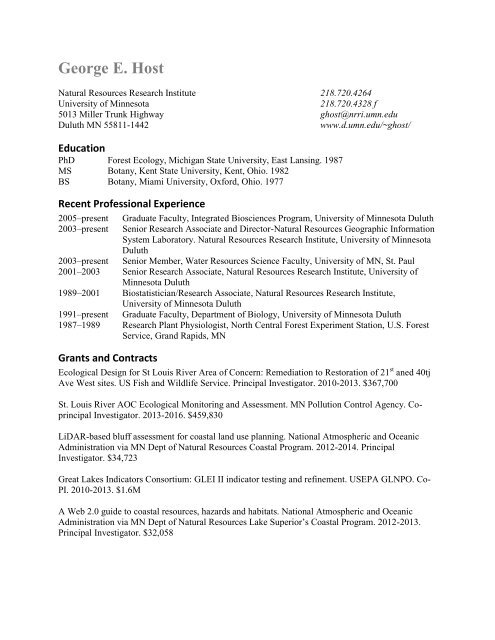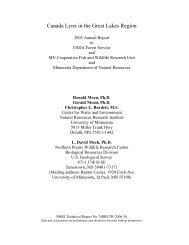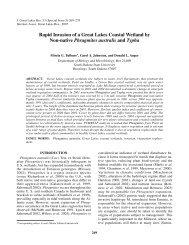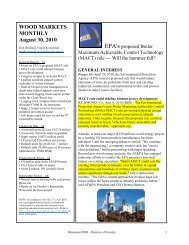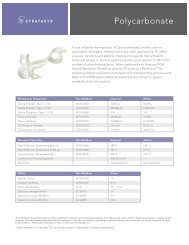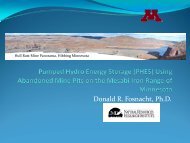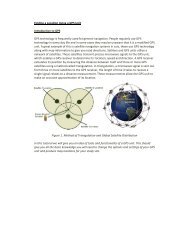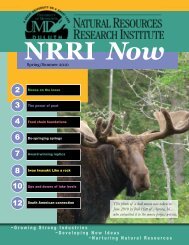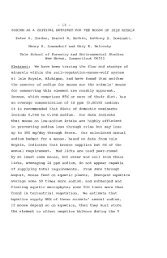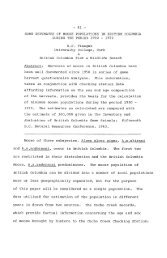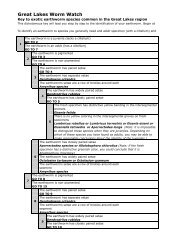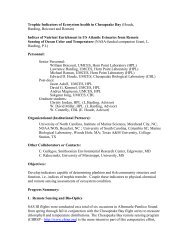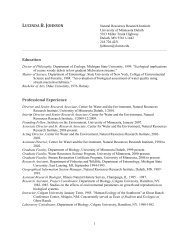George E. Host - Natural Resources Research Institute - University ...
George E. Host - Natural Resources Research Institute - University ...
George E. Host - Natural Resources Research Institute - University ...
- No tags were found...
Create successful ePaper yourself
Turn your PDF publications into a flip-book with our unique Google optimized e-Paper software.
<strong>George</strong> E. <strong>Host</strong><strong>Natural</strong> <strong>Resources</strong> <strong>Research</strong> <strong>Institute</strong> 218.720.4264<strong>University</strong> of Minnesota218.720.4328 f5013 Miller Trunk Highway ghost@nrri.umn.eduDuluth MN 55811-1442www.d.umn.edu/~ghost/EducationPhD Forest Ecology, Michigan State <strong>University</strong>, East Lansing. 1987MS Botany, Kent State <strong>University</strong>, Kent, Ohio. 1982BS Botany, Miami <strong>University</strong>, Oxford, Ohio. 1977Recent Professional Experience2005–present Graduate Faculty, Integrated Biosciences Program, <strong>University</strong> of Minnesota Duluth2003–present Senior <strong>Research</strong> Associate and Director-<strong>Natural</strong> <strong>Resources</strong> Geographic InformationSystem Laboratory. <strong>Natural</strong> <strong>Resources</strong> <strong>Research</strong> <strong>Institute</strong>, <strong>University</strong> of MinnesotaDuluth2003–present Senior Member, Water <strong>Resources</strong> Science Faculty, <strong>University</strong> of MN, St. Paul2001–2003 Senior <strong>Research</strong> Associate, <strong>Natural</strong> <strong>Resources</strong> <strong>Research</strong> <strong>Institute</strong>, <strong>University</strong> ofMinnesota Duluth1989–2001 Biostatistician/<strong>Research</strong> Associate, <strong>Natural</strong> <strong>Resources</strong> <strong>Research</strong> <strong>Institute</strong>,<strong>University</strong> of Minnesota Duluth1991–present Graduate Faculty, Department of Biology, <strong>University</strong> of Minnesota Duluth1987–1989 <strong>Research</strong> Plant Physiologist, North Central Forest Experiment Station, U.S. ForestService, Grand Rapids, MNGrants and ContractsEcological Design for St Louis River Area of Concern: Remediation to Restoration of 21 st aned 40tjAve West sites. US Fish and Wildlife Service. Principal Investigator. 2010-2013. $367,700St. Louis River AOC Ecological Monitoring and Assessment. MN Pollution Control Agency. CoprincipalInvestigator. 2013-2016. $459,830LiDAR-based bluff assessment for coastal land use planning. National Atmospheric and OceanicAdministration via MN Dept of <strong>Natural</strong> <strong>Resources</strong> Coastal Program. 2012-2014. PrincipalInvestigator. $34,723Great Lakes Indicators Consortium: GLEI II indicator testing and refinement. USEPA GLNPO. Co-PI. 2010-2013. $1.6MA Web 2.0 guide to coastal resources, hazards and habitats. National Atmospheric and OceanicAdministration via MN Dept of <strong>Natural</strong> <strong>Resources</strong> Lake Superior’s Coastal Program. 2012-2013.Principal Investigator. $32,058
<strong>George</strong> E. <strong>Host</strong>-Page 2Amity Creek Restoration Project. MN Pollution Control Agency. Co-principal Investigator $427,907.Minnesota’s statewide conservation and preservation plan. Legislative-Citizen Commission onMinnesota <strong>Resources</strong>. $126,000. Jan 2007 – June 2008.Development of environmental indicators of condition, integrity, and sustainability in the GreatLakes basin. U.S. Environmental Protection Agency. Co-Principal Investigator. $6,000,000.Protocols for selecting classification systems and reference conditions: a comparison of methods.U.S. Environmental Protection Agency. Co-Principal Investigator. $747,404.Prioritized monitoring for the Lake Superior basin. US EPA Great Lakes National Protection Office.Principal Investigator-$75,818. Oct 2007 – March 2009.Vegetation characterization and conifer regeneration strategies for the Grand Portage NationalMonument. National Park Service. $35,646. June 2007 – present.Comparison of recent and historic landscape changes by beaver activity in Voyageurs National Park,1927-2005. National Park Service. $28,154. 7/2006 – 6/2007.Development of sampling framework and key protocols for monitoring natural resources of the GreatLakes Network. National Park Service. Principal Investigator $168,045. 7/2004 – 7/2010Scenarios of landscape change effects on tropospheric ozone risk to forests of the Midwest. U.S.Forest Service. Principal Investigator. $80,000. 7/2003 – 9/2007.The Grand Rapids forest legacy project: spatial analyses for the identification of conservationeasement sites. The Nature Conservancy, Principal Investigator. $22,021.Aquatic and wetland ecosystem studies of a restored wild rice lake system. Fond du Lac TribalCommunity College. Principal Investigator. $96,000.An ecological classification and assessment of Minnesota’s northern landscape. MN DNR, PrincipalInvestigator. $25,000.Evaluation of DNR aquatic vegetation surveys data summaries and comparative analysis. MNDepartment of <strong>Natural</strong> <strong>Resources</strong>. Co-Principal Investigator. $50, 000.DuluthStreams heads north: making North Shore stream data make sense to citizens and localofficials. Co-Principal Investigator. $95,619.DuluthStreams.org: Regionalizing surface water education and outreach. Co-Principal Investigator.MN's Lake Superior Coastal Program (MDNR- NOAA-prime). $45,580 (total project = $102,850).Duluth Streams: Community partnerships for understanding urban stormwater and water qualityissues at the head of the Great Lakes. Co-Principal Investigator. U.S. Environmental ProtectionAgency. $211,555.
<strong>George</strong> E. <strong>Host</strong>-Page 3Inventory and classification of Minnesota’s North Shore wetlands for the CoastalGIS project.National Atmospheric and Oceanic Administration via MN Dept of <strong>Natural</strong> <strong>Resources</strong> CoastalProgram. $100,000.Wetland classification and inventory for Carltine and South St. Louis County. National Atmosphericand Oceanic Administration via MN Dept of <strong>Natural</strong> <strong>Resources</strong> Coastal Program. $27,003.Development of monitoring protocols to assess impacts of European earthworm invasions. NationalPark Service. Principal Investigator. $64,600.The North Shore Data Consortium: Acquiring and distributing high-resolution geospatialinformation. MN Lake Superior Coastal Program $39,137. Sept 2009 – Dec 2011Statewide ecological ranking of Conservation Reserve Program lands. MN Board of Soil and Water<strong>Resources</strong> (LCCMR prime). $108,000. March 2009 – June 2011.Weather and Water: Combining Broadcast Meteorology and Stream Data Animations to ProtectSuperior Streams. MN Sea Grant. $95,000. July 2009 – May 2012.Stressor Gradients and Spatial Narratives of the St. Louis River Estuary. MN Sea Grant. $296,166June 2010 – Jan 2014.A Coastal Atlas for Lake Superior’s north shore. MN Lake Superior Coastal Program. $33,759. Aug2010 – May 2012.Effects of herbivores on ground-flora and nutrients. The Nature Conservancy $2000. June 2010- Sept2010.Illustrating the Use of Conservation Easements to Mitigate Effects of Forest Parcelization. MNDepartment of <strong>Natural</strong> <strong>Resources</strong>, $10,000 Dec 2008 – March 2010.Synoptic mapping of native plant communities of the Laurentian Mixed Forest. MN Department of<strong>Natural</strong> <strong>Resources</strong>, $27,894. Nov 2008 – June 2010.Exotic Earthworm Invasions: Integrated <strong>Research</strong> and Education to Achieve <strong>Natural</strong> ResourceProtection. MN Lake Superior Coastal Program. $46,935 August 2008 – December 2010.Quantifying parcelization potential of forest lands in Itasca County, north central Minnesota. MNDept. of <strong>Natural</strong> <strong>Resources</strong>. $40,000 April 2008 – June 2008.Aquatic and wetland ecosystem study of a restored wild rice lake system. Fond du Lac Tribal andCommunity College $24.267. June 2006 – July 2007.Development and evaluation of multi-scale mechanistic indicators of regional landscapes. U.S.Environmental Protection Agency, Office of <strong>Research</strong> and Development. Co-Principal investigator.$998,964.
<strong>George</strong> E. <strong>Host</strong>-Page 4Spatial analysis of forest landscape conditions of Northern Minnesota. MN Dept of <strong>Natural</strong><strong>Resources</strong>. Principal Investigator. $45,000.Assessment and development of water quality monitoring for parks in the National Parks ServiceGreat Lakes Network. National Park Service. Co-principal Investigator. $46,650.Training water science technicians for the future-a national online curriculum using advancedtechnologies and real-time data. National Science Foundation. Co-Principal Investigator. $600,000.Impacts of greenhouse gases (CO 2 , O 3 ) on carbon sequestration and storage in a regeneratingnorthern hardwood forest: the FACTS II (Aspen FACE) Study. Michigan Technological<strong>University</strong>/U.S. Department of Energy, Co-Principal Investigator. $2,159,648.Modeling impacts of CO 2 , ozone, and climate change on tree growth: an ecophysiological whole-treegrowth process approach. U.S. Forest Service/U.S. Department of Energy. Principal Investigator.$226,000.Lake Access: Managing urban runoff using real-time, community-based monitoring to improve lakewater quality. U.S. Environmental Protection Agency/Suburban Hennepin Regional Park District.Principal Investigator $400,000.Lake Access: Making water quality data real and relevant for Minnesotans. U.S. EnvironmentalProtection Agency/Suburban Hennepin Regional Park District. Principal Investigator $425,000.Landscape modeling of white pine blister rust. Cloquet Forestry Center, G.E. <strong>Host</strong> and M.A. White.$34,000.Predicting water and forest resources health and sustainability. Legislative Council on Minnesota<strong>Resources</strong>, Co-Principal Investigator. $461,574.Impact of harvesting on regeneration, productivity and floristic diversity of quaking aspen andnorthern hardwood ecosystems. MN Forest <strong>Resources</strong> Council. Co-Principal Investigator. $185,000.Impact of harvesting on forest regeneration and productivity. North Central Forest ExperimentStation. Co-Principal Investigator, $30,000.Geographic information and decision support tools for land use planning in the Minnesota LakeSuperior Coastal Zone. MN Dept. of <strong>Natural</strong> <strong>Resources</strong>/National Oceanic and AtmosphericAdministration. Principal Investigator. $77,700.CoastalGIS: Delivering spatial information for land use planning on Minnesota’s North Shore.52,688. 8/2005 – 12/2007. MN Dept. of <strong>Natural</strong> <strong>Resources</strong>/National Oceanic and AtmosphericAdministration. Principal Investigator. $52.688.Mapping native plant communities of the Northern Superior Uplands. MN Dept of <strong>Natural</strong><strong>Resources</strong>. Principal Investigator. $45,000.
<strong>George</strong> E. <strong>Host</strong>-Page 5Hierarchical parallel algorithms for simulating plant response to environmental stress. NationalScience Foundation. Principal Investigator. $380,073.Lake Superior decision support systems. MN Department of <strong>Natural</strong> <strong>Resources</strong>/U.S. EnvironmentalProtection Agency. Principal Investigator. $514,619.Water on the web: monitoring Minnesota lakes on the Internet. National Science Foundation.Munson, B., R. P. Axler, G. E. <strong>Host</strong>, C. A. Hagley, and C. J. Owen. $685,000.Great Lakes assessment: spatial analysis of landscape pattern, decision support and data visualizationsystems. U.S. Forest Service. G. E. <strong>Host</strong>-$100,500.Forest-atmosphere carbon transfer and storage-II (FACTS II): Interacting effects of elevated CO 2 andO 3 on aspen forest ecosystems. NSF/DOE/NASA/USDA Joint Program on Terrestrial Ecology andGlobal Change. Co-Principal Investigator-$498,997.Modeling impacts of CO 2 , ozone, and climate change on tree growth: I an ecophysiological wholetreeapproach. U.S. Forest Service, Northern Stations Global Change Program. G. E. <strong>Host</strong>, J.Isebrands, and M. Rauscher. $60,000 10/91-8/96.Modeling impacts of CO 2 , ozone, and climate change on tree growth II: Scaling from individual treesto populations. U.S. Forest Service, Northern Stations Global Change Program. G. E. <strong>Host</strong>, G.Theseira, and J. Isebrands. $50,000. 5/94-5/96.Interacting effects of CO 2 , and O 3 on aspen forest ecosystems. U.S. Forest Service, Northern StationsGlobal Change Program. G. E. <strong>Host</strong>, G. Theseira, and J. Isebrands. $228,000. 3/96-4/2008.Ecological effects of commercial thinning in 30 year old aspen. Blandin Paper Company/MNDepartment of <strong>Natural</strong> <strong>Resources</strong>. G. E. <strong>Host</strong> and M. A. White. $20,000. 11/97-12/98.ECOPHYS/EPIC: Developing a process-level model of hybrid poplar plantations for EPIC, anerosion/productivity impact model. Department of Energy via USFS. G. E. <strong>Host</strong> 149,000. 4/94-9/97.Minnesota environmental indicators initiative. G. E. <strong>Host</strong> and C. Richards. 12/96- 6/97. $60,000Development of ecological criteria in Midwestern watersheds. Environmental Protection Agency-ERL Duluth C. Richards, G. E. <strong>Host</strong>, L. Johnson. $250,000 10/93-12/96Effects of soil compaction and organic matter removal on long-term site productivity and groundfloradiversity. U.S. Forest Service. G. E. <strong>Host</strong>. $70,000. 6/90-PresentAssessing site suitability for land application of biosolids in St. Louis, Carlton, and Douglas counties.G. E. <strong>Host</strong> and P. Polzer. Western Lake Superior Sanitary District $2,400. 9/95.Succession and productivity of Minnesota’s forest ecosystems. G. E. <strong>Host</strong> and J. Pastor. MNDepartment of <strong>Natural</strong> <strong>Resources</strong>. $31,808. 10/94-10/95.
<strong>George</strong> E. <strong>Host</strong>-Page 6High resolution climatic classification of the northern Lake States. North Central Forest ExperimentStation. G. E. <strong>Host</strong> and D. J. Mladenoff. $10,000. 2/94-8/95.Structure and function of regional landscapes. North Central Forest Experiment Station. D.Mladenoff, G. E. <strong>Host</strong>, and T.R. Crow. $392,445. 7/91-6/95.Development of biocriteria for regional watersheds through integrated watershed and reach-scaleanalyses. Environmental Protection Agency. C. Richards, G. E. <strong>Host</strong>, L. Johnson. $248,000.8/91-7/95.Development of ecological criteria in Midwestern watersheds. Environmental Protection Agency-Environmental <strong>Research</strong> Laboratory-Duluth. C. Richards, G. E. <strong>Host</strong>, L. Johnson. $250,000 10/93-12/96.Quantitative methods for risk assessment. Environmental Protection Agency S. Basak, B. Hunter, G.E. <strong>Host</strong>, and G. Niemi $350,000 3/92-6/95.An ecophysiological model of root-soil processes. U.S. Forest Service, Northern Forests GlobalChange Program. G. E. <strong>Host</strong>, J. Isebrands, and M. Rauscher. $24,000. 10/92-9/94.Water quality criteria analyses/analysis of toxicity data. U.S. Environmental Protection Agency. G.E. <strong>Host</strong> and R. Regal. $24,000 10/91-9/92.Computer databases, programs, and analyses of acute toxicity data. <strong>University</strong> of WisconsinSuperior. G. E. <strong>Host</strong> and R. Hunter. $16,400. 7/92-9/92.GIS for the Superior National Forest-Toimi opportunity area analysis. Superior National Forest. G. E.<strong>Host</strong>, L. Johnson, J. Pastor. $7,250, 8/91-4/93.Use of ecological land classification and geographic information systems to assess habitat suitabilityfor black bear. USDA Forest Service. G. E. <strong>Host</strong> and L. Johnson. $5,000. 9/90-12/92.Vegetation data management software for entry, verification, and multivariate analysis. OttawaNational Forest. G. E. <strong>Host</strong> and A. Lima, $5000 5/92-9/92.Effects of leaf shape on light interception and photosynthate production in Populus. PrincipalInvestigators: G. E. <strong>Host</strong> and D. Dickmann (Michigan State <strong>University</strong>). $3,500.Refereed PublicationsLoss, S., R. Hueffmeier, C. M. Hale, G. E. <strong>Host</strong>, G. Sjerven and L. E. Frelich. 2013. EarthwormInvasions in northern hardwoods forests: a rapid assessment method. <strong>Natural</strong> Areas Journal 33:21-30.<strong>Host</strong>, G.E., T. N Brown, T.P. Hollenhorst, L.B. Johnson, and J.J.H.Ciborowski. 2011. Highresolutionassessment and visualization of environmental stressors in the Lake Superior basin.Aquatic Ecosystem Health and Management Society 14:376-385.Niemi,G.J., E.D.Reavie, G.S.Peterson, J.R. Kelly, C.A. Johnston, L.B. Johnson, R.W. Howe, G.E.
<strong>George</strong> E. <strong>Host</strong>-Page 7<strong>Host</strong>, T.P. Hollenhorst, N.P. Danz, J.J.H. Ciborowski,T.N. Brown, V.B. Brady, and R.P. Axler. Anintegrated approach to assessing multiple stressors for coastal Lake Superior. Aquatic EcosystemHealth and Management Society 14:356-375.Ruzycki, E.M., R. P. Axler, J.R. Henneck, N. Will and G. E. <strong>Host</strong>. Estimating mercuryconcentrations and loads from four western Lake Superior watersheds using continuous in-streamturbidity monitoring. Aquatic Ecosystem Health and Management Society 14:422-432.Johnson, L.B. and G.E. <strong>Host</strong>. 2010. Recent developments in landscape approaches for the study ofaquatic ecosystems. J. N. Am. Benthol. Soc. 29:41-66.Lenz, K.E., G. E. <strong>Host</strong>, K. Roskoski, A. Noormets, A. Sober and D. F. Karnosky. 2010. Analysis ofa Farquhar-von Caemmerer-Berry leaf-level photosynthetic rate model for Populus tremuloides inthe context of modelling and measurement limitations. Environmental Pollution 158:1015-1022.Hutchens, J.J., J.A. Schuldt, C. Richards, L.B. Johnson, G.E. <strong>Host</strong>, and D.H. Breneman. 2009.Multi-scale mechanistic indicators of Midwestern USA stream macroinvertebrates. EcologicalIndicators 9:1138-1150.<strong>Host</strong>, G.E., H.W. Stech, K.E.Lenz, K. Roskoski, and R. Mather. 2008. Forest patch modeling: usinghigh performance computing to simulate aboveground interactions among individual trees.Functional Plant Biology 35:976-987.White, M.A. and G.E. <strong>Host</strong>. 2008. Forest disturbance frequency and patch structure from pre-European settlement to present in the Mixed Forest Province of Minnesota, USA. Can. J. of Forest<strong>Research</strong> 38:2212-2226.Bourgeau-Chavez, L., R.D. Lopez, A. Trebitz, T. Hollenhorst, G.E. <strong>Host</strong>, B. Huberty, R.L. Gauthier,and J. Hummer. 2008. (p 143-171) Landscape-based Indicators. In: T. Burton, J.C. Brazner, J.J.H.Ciborowski, G.P. Grabas, J. Hummer, J. Schnieder, and D.G. Uzarski, eds. Great Lakes CoastalWetlands Monitoring Plan: Landscape-based Indicators. Great Lakes Commission, Ann Arbor.Hollenhorst, T.P., Brown, T.N., Johnson, L.B., Ciborowski, J.J.H., Hollenhorst, T. P., Brown, T. N.,Johnson, L. B., Ciborowski, J. J. H., and <strong>Host</strong>, G. E. 2007. Methods for generating multi-scalewatershed delineations for indicator development in Great Lake Coastal ecosystems. J. Great LakesRes. 33 (Special Issue 3) 13-26.Brazner, J. C., Danz, N. P., Trebitz, A. S., Niemi, G. J., Regal, R. R., Hollenhorst, T. P., <strong>Host</strong>, G. E.,Reavie, E. D., Brown, T. N., Hanowski, J. M., Johnston, C. A., Johnson, L. B., Howe, R. W., andCiborowski, J. J. H. 2007. Responsiveness of Great Lakes wetland indicators to human disturbancesat multiple spatial scales: a multi-assemblage assessment. J. Great Lakes Res. 33 (Special Issue 3)42-66.Danz, N. P., G. J. Niemi, R. R. Regal, T. Hollenhorst, L. B. Johnson, J. M. Hanowski, R. Axler, J. J.H. Ciborowski, T. Hrabik, V. J. Brady, J. R. Kelly, J. A. Morrice, J. C. Brazner, R. W. Howe, C. A.Johnston, and G. E. <strong>Host</strong>. 2007. Integrated gradients of anthropogenic stress in the U.S. Great Lakesbasin. Environmental Management 39:631-647.
<strong>George</strong> E. <strong>Host</strong>-Page 8Hollenhorst, T. P., G. E. <strong>Host</strong>, and L. B. Johnson. Scaling issues in mapping riparian zones withremote sensing data. 2006. In: (Wu, J., K.B. Jones, H. Li, and O.L. Loukes, eds) Scaling andUncertainty Analysis in Ecology: Methods and Applications. Springer, p 271-291.Johnson, L. B., G. E. <strong>Host</strong>, J. Olker, and C. Richards. 2006. Landscape and reach scale predictors oflarge wood abundance in low-gradient streams. In: (Hughes, R. M, L. Wang and P. W. Seelbackeds). Landscape Influences on Stream Habitats and Biological Assemblages. American FisheriesSociety Symposium 48:151-173.<strong>Host</strong>, G. E., J. Schuldt, J. J. Ciborowski, L. B. Johnson, T. Hollenhorst, and C. Richards. 2005. Useof GIS and remotely-sensed data for a priori identification of reference areas for Great Lakes coastalecosystems. International J. of Remote Sensing 26: 5325-5342.Danz, N. P., R. R. Regal, G. J. Niemi, V. Brady, T. Hollenhorst, L. B. Johnson, G. E. <strong>Host</strong>, J. M.Hanowski, C. A. Johnston, T. Brown, J. Kingston, and J. Kelly R. 2005. Environmentally stratifiedsampling design for the development of Great Lakes environmental indicators. EnvironmentalMonitoring & Assessment 102:41-65.Schomberg, J.D., G.E. <strong>Host</strong>, L.B. Johnson, and C. Richards. 2005. Evaluating the influence oflandform, surficial geology and land use on streams using hydrologic simulation modeling. AquaticSciences 67:393-548.Angelstam, Per, Stan Boutin, Fiona Schmiegelow, Marc-André Villard, Pierre Drapeau, <strong>George</strong><strong>Host</strong>, John Innes, Grigoriy Isachenko, Timo Kuuluvainen, Mikko Mönkkönen, Gerald Niemi, Jean-Michel Roberge, John Spence, Duncan Stone. 2004. Targets for boreal forest biodiversityconservation-a rationale for macroecological research and adaptive management. Ecological Bulletin51:487-509.Berger, A. L, K. J. Peuttmann and G. E. <strong>Host</strong>. Harvesting impacts on soil and understory vegetation:The influence of season of harvest and within-site disturbance patterns in clearcut Aspen stands inMinnesota. 2004. Canadian Journal of Forest <strong>Research</strong> 43:2159-2168.Karnosky, D.F., D.R. Zak, K.S. Pregitzer, C.S. Awmack, J.G. Bockheim, R.E. Dickson, G.R.Hendrey, G. E. <strong>Host</strong>, W.S. Jones, J.S. King, B.J. Kopper, E.L. Kruger, M.E. Kubiske, R.L. Lindroth,W.J. Mattson, E.P. McDonald, A. Noormets, E. Oksanen, W.F.J. Parsons, K.E. Percy, G.K. Podila,D.E. Riemenschneider, P. Sharma, A. Sober, J. Sober, S. Anttonen, E. Vapaavuori, and J.G.Isebrands. 2003. Tropospheric O 3 moderates responses of temperate hardwood forests to elevatedCO 2 : a synthesis of molecular to ecosystem results from the Aspen FACE project. FunctionalEcology 17:289-304.Munson, B. H. R. Huber, R. P. Axler, G. E. <strong>Host</strong>, C. Hagley, C. Moore, and G. Merrick. 2003. Fieldtrips online: investigating water quality through the Internet. Science Teacher 70:44-49.Theseira, G.W., G. E. <strong>Host</strong>, J. G. Isebrands, and F. D. Whisler. 2003. SOILPSI: A potential-driventhree-dimensional soil water redistribution model: description and comparative evaluation.Environmental Software and Modeling 18:13-23.
<strong>George</strong> E. <strong>Host</strong>-Page 9White, M. A., T. N. Brown and G. E. <strong>Host</strong>. 2002. Landscape analysis of risk factors for white pineblister rust in the Mixed Forest Province of Minnesota, U.S.A. Canadian Journal of Forest <strong>Research</strong>32:1639-1650.Laconite, A., J. G. Isebrands, and G. E. <strong>Host</strong>. 2002 A new way to account for the effect of sourcesinkspatial relationships in whole plant carbon allocation models. Canadian Journal of Forest<strong>Research</strong> 32:1838-1848.Martin, M. J., G. E. <strong>Host</strong>, K. E. Lenz, and J. G. Isebrands. 2001. Simulating the growth response ofaspen to elevated ozone: a mechanistic approach to scaling a leaf-level model of ozone effects onphotosynthesis to a complex canopy architecture. Environmental Pollution 115: 425-436.<strong>Host</strong>, G. E., L. B. Johnson, C. Richards, and P. Collins. 2000. Geographic information and tools forinformed decisions: the Lake Superior Decision Support project. In: Environmental Problem Solvingwith Geographic Information Systems 1994 and 1999 Conference Proceedings. EnvironmentalProtection Agency Document Number EPA/625/R-00/010. 11 p.<strong>Host</strong>, G. E., N. R. Will, R. P. Axler, C.J. Owen, and B. H. Munson. 2000. Interactive technologiesfor collecting and visualizing water quality data. Journal of the Urban and Regional InformationSystems Association 12:39-45.Isebrands, J. G., G. E. <strong>Host</strong>, K.E. Lenz, G. Wu, H. W. Stech. 2000. Hierarchical, parallel computingstrategies using component object model for process modelling responses of forest plantations tointeracting multiple stresses. In: (R.J.M. Ceuelemans, F. Veroustraete, V. Gond, and J.B.H.F. VanRensbergen eds.) Forest Ecosystem Modeling, Upscaling, and Remote Sensing, SPB AcademicPublishing, Hague, Netherlands. pp 123-135.Crow, T. R., G. E. <strong>Host</strong>, and D. J. Mladenoff. 1999. Ownership and ecosystem as sources of spatialheterogeneity in a forested landscape, Wisconsin, USA. Landscape Ecology 14:449-463.<strong>Host</strong>, G. E., B. H. Munson, R. P. Axler, C. A. Hagley, G. Merrick, and C. J. Owen. 1999. Water onthe web: students monitoring Minnesota rivers and lakes over the Internet. Proceedings: AWRASymposium on Water <strong>Resources</strong> and the World Wide Web, Seattle, WA. Dec 5-9, 1999.http://www.awra.org//proceedings/www99/w74/index.htm.<strong>Host</strong>, G. E., G. W. Theseira, C. Heim, J. G. Isebrands and R. Graham. 1999. EPIC-ECOPHYS: Alinkage of empirical and process models for simulating poplar plantation growth. In: (A. Amaro andM. Tome Eds.) Empirical and Process Models for Forest Tree and Stand Growth Simulation. EdicosSalamandra pp. 419-429.Isebrands, J. G., G. E. <strong>Host</strong>, K. McTavish and K. E. Lenz. 1999. Modeling short-rotation forestplantations using hierarchical, parallel computing: A developmental history of ECOPHYS. In: (A.Amaro and M. Tome, eds.) Empirical and Process Models for Forest Tree and Stand GrowthSimulation. Edicos Salamandra pp. 537-51.Basak, S. C., G. D. Grunwald, G. E. <strong>Host</strong>, G. J. Niemi, and S. P. Bradbury. 1998. A comparativestudy of molecular similarity, statistical and neural methods for predicting toxic modes of action.Environmental Toxicology and Chemistry 17:1056-1064.
<strong>George</strong> E. <strong>Host</strong>-Page 10<strong>Host</strong>, G. E. and J. Pastor. 1998. Modeling forest succession among ecological land units in northernMinnesota. Conservation Ecology, [online] 2(2): 15. Available from the Internet.http://www.consecol.org/vol2/iss2/art15.Richards, C., R.J. Haro, L.B. Johnson, and G. E. <strong>Host</strong>. 1997. Catchment and reach-scale propertiesas indicators of macroinvertebrate species traits. Freshwater Biology 37:219-230.Johnson, L.B., C. Richards, G. E. <strong>Host</strong>, and J.W. Arthur. 1997. Landscape influences on waterchemistry in Midwestern stream ecosystems. Freshwater Biology 37:193-207.<strong>Host</strong>, G. E., P. L. Polzer, D. J. Mladenoff, M. A. White, and T. R. Crow. 1996. A quantitativeapproach to developing regional ecosystem classifications. Ecological Applications 6:608- 618.<strong>Host</strong>, G. E., J. G. Isebrands, G.W. Theseira, J.R. Kiniry, and R.L. Graham. 1996. Temporal andspatial scaling from individual trees to plantations: a modeling strategy. Biomass and Bioenergy11:233-243.<strong>Host</strong>, G. E., J.G. Isebrands, and K. Perttu. 1996. Modeling short rotation forestry growth: aninternational workshop. Biomass and Bioenergy 11:73-74.Isebrands, J.G., G. E. <strong>Host</strong>, L. Bollmark, J. Porter, S. Philippot, E. Stevens, and K. Rushton. 1996. Astrategy for process modelling of short rotation Salix coppice plantations. Biomass and Bioenergy:11:245-252.McDonald, M.E., C.A. Tikkanen, R.P. Axler, C.P. Larsen and G. E. <strong>Host</strong>. 1996. Fish simulationculture model (FIS-C): a bioenergetics based model for aquacultural wasteload application.Aquacultural Engineering 15:243-259.Perala, D. A., G. E. <strong>Host</strong>, J. K. Jordan, and C. J. Cieszewski. 1996. A multiproduct growth and yieldmodel for the circumboreal aspens. Northern Journal of Applied Forestry 13:164-170.Richards, C., L.B. Johnson, and G. E. <strong>Host</strong>. 1996. Landscape-scale influences on stream habitats andbiota. Can. J. Fish. Aquat. Sci. 53:295-311.Nute, D. E., H. M. Rauscher, D. A. Perala, G. Zhu, Y. Chang, and G. E. <strong>Host</strong>. 1995. A toolkitapproach to developing forest management advisory systems in PROLOG. AI Applications in<strong>Natural</strong> <strong>Resources</strong> 9:39-58.Rauscher, H. M., D. E. Nute, D. A. Perala, G. Zhu, Y. Chang, G. E. <strong>Host</strong>, and J. W. Benzie. 1995.The forest management advisory system. AI Applications in <strong>Natural</strong> <strong>Resources</strong> 9:60.Wolter, P. T., D. J. Mladenoff, G. E. <strong>Host</strong>, and T. R. Crow. 1995. Improved forest classification inthe northern Lake States using multi-temporal Landsat imagery. Photogrammetric Engineering andRemote Sensing 61(9):1129-1143.<strong>Host</strong>, G. E. and J. G. Isebrands. 1994. An interregional validation of ECOPHYS, a growth processmodel of juvenile poplar clones. Tree Physiology 14:933-945.
<strong>George</strong> E. <strong>Host</strong>-Page 11Richards, C. and G. E. <strong>Host</strong>. 1994. Examining land use influences on stream habitats andmacroinvertebrates: A GIS approach. Water <strong>Resources</strong> Bulletin 30:729-738.Richards, C, G. E. <strong>Host</strong>, and J. W. Arthur. 1993. Identification of predominant environmental factorsstructuring stream macroinvertebrate communities within a large agricultural catchment. FreshwaterBiology 29:285-294.<strong>Host</strong>, G. E. and K. S. Pregitzer. 1992. Geomorphic influences on ground-flora and overstorycomposition in upland forests of northwestern Lower Michigan. Canadian Journal of Forest <strong>Research</strong>22:1547-1555.<strong>Host</strong>, G. E., H.M. Rauscher, and D. Schmoldt. 1992. SYLVATICA: An integrated framework forforest landscape simulation. Landscape and Urban Planning 22:281-284.<strong>Host</strong>, G. E. and K.S. Pregitzer. 1991. Ecological species groups for upland forest ecosystems ofnorthwestern Lower Michigan. Forest Ecology and Management. 43:87-102.<strong>Host</strong>, G. E., J.G. Isebrands, H.M. Rauscher, and D.A. Michael. 1990. Validation of photosynthateproduction in ECOPHYS, an ecophysiological growth process model of Populus. Tree Physiology7:283-296.Rauscher, H.M. and G. E. <strong>Host</strong>. 1990. Hypertext and AI: a complementary combination forknowledge management. AI Applications in <strong>Natural</strong> Resource Management 4:58-61.Rauscher, H. M., J. G. Isebrands, G. E. <strong>Host</strong>, R. E. Dickson, D. I. Dickmann, T. R. Crow, and D. A.Michael. 1990. ECOPHYS: an ecophysiological growth process model of poplar. Tree Physiology7:255-281.Zak, D.R., G. E. <strong>Host</strong>, and K.S. Pregitzer. 1989. Regional variability in nitrogen cycling andoverstory biomass in northern Lower Michigan. Canadian Journal of Forest <strong>Research</strong> 9:1521-1526.<strong>Host</strong>, G. E., K.S. Pregitzer, C.W. Ramm, D.P. Lusch, and D.T. Cleland. 1988. Variation in overstorybiomass among glacial landforms and ecological land units in northwestern Lower Michigan.Canadian Journal of Forest <strong>Research</strong> 18:659-668.<strong>Host</strong>, G. E. K. S. Pregitzer, C. W. Ramm, J. B. Hart, and D. T. Cleland. 1987. Landform-mediateddifferences in successional pathways among upland forest ecosystems in northwestern LowerMichigan. Forest Science 33:445-457.Zak, D. R., K. S. Pregitzer, and G. E. <strong>Host</strong>. 1986. Landscape variation in nitrogen mineralization andnitrification. Canadian Journal of Forest <strong>Research</strong> 16:1258-1263.Andreas, B. K. and G. E. <strong>Host</strong>. 1983. Development of a Sphagnum bog on the floor of a sandstonequarry in northeastern Ohio. Ohio Journal of Science 83:246-253.<strong>Host</strong>, G. E. and S. J. Mazzer. 1982. An Ohio record for Tuber texense (Heimsch). Ohio Journal ofScience 82:142
<strong>George</strong> E. <strong>Host</strong>-Page 12Technical ReportsAlban, D. H, G. E. <strong>Host</strong>, J. D. Elioff, and D. Shadis. 1994. Soil and vegetation response to soilcompaction and forest floor removal after aspen harvesting. USDA Forest Service North CentralForest Experiment Station <strong>Research</strong> Paper NC-315. 8 p.Arthur, J.W., T. Roush, J.A. Thompson, F.A. Puglisi, C. Richards, G. E. <strong>Host</strong>, and L.B. Johnson.Evaluation of watershed quality in the Saginaw River basin. U.S. Environmental Protection Agency,Office of <strong>Research</strong> and Development, Duluth, MN. EPA/600/R95/153.Axler, R., C. Tikkanen, M. McDonald, C.Larsen, and G. E. <strong>Host</strong>. 1993. Fish bioenergetics modelingto estimate waste loads from a net-pen aquaculture operation. In: (J. Wang ed) Proceedings Modelingand Management Techniques for Aquaculture Operations, June 21-23, 1993, Spokane, WA.Axler, R.P, E. Ruzycki, G. E. <strong>Host</strong> and J. Henneck. 2006. Historical water quality data assessment ofthe Great Lakes inventory and monitoring network. NRRI Technical Report NRRI/TR-2006/05.Axler, R. P., J. Barten, G. E. <strong>Host</strong>, B. H. Munson, C. A. Hagley, B. Luikkonen, and C. J. Owen.2000. Water on the Web and Lake Access: some lessons from continuous lake monitoring. Focus10,000 11:17-20Axler, R., N.Will, E.Ruzycki, G. E. <strong>Host</strong>, C.Hagley, J.Henneck, T.Carlson, J.Schomberg, G.Sjerven,C.Kleist. 2010. Data for discovery and decision-making: LakeSuperiorStreams.org. NRRI TechnicalReport NRRI/TR-2010/08.Basak, S. C., B. Hunter, G. Niemi, and G. E. <strong>Host</strong>. 1993. Report of the international workshop onmolecular similarity in risk assessment. EPA/CR 819621-01-0. NRRI Technical Report No,NRRI/TR-93/09.Berguson, W. E. and G. E. <strong>Host</strong>. 1995. Analysis of stand stocking relationships and basal areagrowth rate among ecological land units in north central Minnesota. <strong>Natural</strong> <strong>Resources</strong> <strong>Research</strong><strong>Institute</strong>. NRRI/TR-95/44 7 pp.Boeder, J.E., Y. Xin, M.A. White, D.J. Mladenoff, and G. E. <strong>Host</strong>. 1995. Spatial analysis package(apack): user's guide and technical documentation. Duluth, MN. <strong>Natural</strong> <strong>Resources</strong> <strong>Research</strong><strong>Institute</strong>. NRRI/TR-95/26 16 p.Brady, V., C. Reschke, D. Breneman, G. E. <strong>Host</strong> and L. B. Johnson. 2010. 40 th Avenue Westremediation to restoration project: biological survey results. <strong>Natural</strong> <strong>Resources</strong> <strong>Research</strong> <strong>Institute</strong>.NRRI/TR-2010/24 23 pp.Brown, T.N., L. B. Johnson and G. E. <strong>Host</strong>. 2011 Lake Superior Stream Sediment Study. <strong>Natural</strong><strong>Resources</strong> <strong>Research</strong> <strong>Institute</strong>. NRRI/TR-2011/35.Ciborowski, J.J.H., G. E. <strong>Host</strong>, T. N. Brown, P. Meysembourg, and L. B. Johnson. 2011. LinkingLand to the Lakes: The Linkages between Land-based Stressors and Conditions of the Great Lakes.<strong>Natural</strong> <strong>Resources</strong> <strong>Research</strong> <strong>Institute</strong>. NRRI/TR-2011/45. 46 p.
<strong>George</strong> E. <strong>Host</strong>-Page 13Cleland, D. T., J. B. Hart, G. E. <strong>Host</strong>, K. S. Pregitzer, and C. W. Ramm. 1994. Field guide:ecological classification and inventory system of the Huron-Manistee national forests. USDA ForestService Huron-Manistee National Forest, Cadillac, MI. 245 p.Dickson, R. E., K. F. Lewin, J. G. Isebrands, M. D. Coleman, W. E. Heilman, D. E.Riemenschneider, J. Sober, G. E. <strong>Host</strong>, D. R. Zak, G. R. Hendrey, K. S. Pregitzer, and D. F.Karnosky. 2000. Forest atmosphere carbon transfer and storage-II (FACTS-II)-the aspen free-air CO 2and O 3 enrichment (FACE) project: an overview. General Technical Report NC-214, North CentralExperiment Station, St. Paul, MN, 68 p.Hale, C.M. and G. E. <strong>Host</strong>. 2005. Assessing the impacts of European earthworm invasions in beechmaplehardwood and aspen-fir boreal forests of the western Great Lakes region. National ParkService Great Lakes Inventory and Monitoring Network Report GLKN/2005/11.<strong>Host</strong>, G. E. 1996. Effects of soil compaction and organic matter removal on ground-flora diversity inthe Great Lakes forests. <strong>Natural</strong> <strong>Resources</strong> <strong>Research</strong> <strong>Institute</strong> Technical Report. NRRI/TR-96/16.<strong>Host</strong>, G. E., C. M. Hale, J. Geissler, P. Collins, R. P. Axler and G. Sjerven. 2007. Stormwatermanagement planning guide and landowner-friendly IMS website tool. NRRI Technical ReportNRRI/TR-2007/10. 13 p.<strong>Host</strong>, G. E., P. Meysembourg, C. Reschke, V. Brady, G. Niemi, A. Bracey and L. Johnson. 2012. Anecological design for the 40th Avenue West Remediation-to-Restoration Project. <strong>Natural</strong> <strong>Resources</strong><strong>Research</strong> <strong>Institute</strong>. NRRI/TR-2012/27 57 p.<strong>Host</strong>, G.E., C. Reschke, V. Brady, D. Breneman, J. Dumke, G. Niemi, J. Austin, M. James, and L.Johnson. 2012. 21st Avenue West Remediation-to-Restoration Project: Biological Survey Results.Report to US Fish and Wildlife Service, 29 p.<strong>Host</strong>, G. E. and J. Pastor. 1995. Modeling forest succession among ecological land units in northernMinnesota. <strong>Natural</strong> <strong>Resources</strong> <strong>Research</strong> <strong>Institute</strong> Technical Report. NRRI/TR-95/43 33 p.<strong>Host</strong>, G. E. and G. Sjerven. 2008. CoastalGIS: delivering spatial information for land use planningon Minnesota’s north shore. <strong>Natural</strong> <strong>Resources</strong> <strong>Research</strong> <strong>Institute</strong> Technical Report. NRRI/TR-2008/07 16 p.<strong>Host</strong>, G. E. 1993. Floristic differences in permanent openings among ecological land units and afterfire. <strong>Natural</strong> <strong>Resources</strong> <strong>Research</strong> <strong>Institute</strong> Technical Report NRRI/TR-94/04. 33 p.<strong>Host</strong>, G. E. and J. G. Isebrands. 1997. Modeling the effects of climatic extremes on early growth ofpoplar under short rotation intensive culture. North Central Forest Experiment Station GeneralTechnical Report NC-196, 7 p.<strong>Host</strong>, G. E., M. A. White, P. L. Polzer, and P. T. Wolter. 1997. Great Lakes assessment: assessinglandscape pattern and structure in Lake States forests. <strong>Natural</strong> <strong>Resources</strong> <strong>Research</strong> <strong>Institute</strong>Technical Report NRRI/TR-97/03. 28 p.
<strong>George</strong> E. <strong>Host</strong>-Page 14<strong>Host</strong>, G. E. and P. L. Polzer. 1996. Assessing site suitability for land application of biosolids in St.Louis, Carlton, and Douglas counties. <strong>Natural</strong> <strong>Resources</strong> <strong>Research</strong> <strong>Institute</strong> Technical ReportNRRI/TR-96/10. 28 p.<strong>Host</strong>, G. E. and P. L. Polzer. 1997. A comparison of forest cover classifications in the Great Lakesregion based on AVHRR and Landsat Thematic Mapper imagery. <strong>Natural</strong> <strong>Resources</strong> <strong>Research</strong><strong>Institute</strong> Technical Report NRRI/TR-97/06. 14 p.<strong>Host</strong>, G. E., P Meysembourg, C. Reschke, V. Brady, G. Niemi, A Bracey, L. Johnson, M. James, J.Austin and E. Buttermore. 2013. An ecological design for the 21 st Avenue West Remediation-to-Restoration Project. <strong>Natural</strong> <strong>Resources</strong> <strong>Research</strong> <strong>Institute</strong> Technical Report NRRI/TR-2013/34. 186p.<strong>Host</strong>, G. E., C. Reschke, V. Brady, D. Breneman, J. Dumke, G.Niemi, J.Austin, M. James and L.Johnson. 2012. 21st Avenue West Remediation to Restoration Project: Biological Survey andHydrodynamic Modeling Results. <strong>Natural</strong> <strong>Resources</strong> <strong>Research</strong> <strong>Institute</strong> Technical Report NRRI/TR-2012/27. 29 p.<strong>Host</strong>, G. E., T. Hollenhorst, T. N. Brown and L. B. Johnson. 2010. Quantifying parcelizationpotential of forest lands in Itasca County, north central Minnesota. <strong>Natural</strong> <strong>Resources</strong> <strong>Research</strong><strong>Institute</strong> Technical Report NRRI/TR-2010/3. 26 p.<strong>Host</strong>, G. E. and T.N. Brown. 2006. Minnesota forests and the range of natural variation. <strong>Natural</strong><strong>Resources</strong> <strong>Research</strong> <strong>Institute</strong> Technical Report NRRI/TR-2006/05. 12 p.<strong>Host</strong>, G. E. and T. N. Brown. 2009. Quantifying parcelization potential of forest lands in ItascaCounty, north central Minnesota. <strong>Natural</strong> <strong>Resources</strong> <strong>Research</strong> <strong>Institute</strong> Technical Report NRRI/TR-09/37. 16 p.<strong>Host</strong>, G. E., T. Brown, and P. Meysembourg. 2006. An ecological classification and assessment ofMinnesota’s northern landscape. <strong>Natural</strong> <strong>Resources</strong> <strong>Research</strong> <strong>Institute</strong> Technical Report NRRI/TR-2006/30 23 p.<strong>Host</strong>, G. E., P. L. Polzer, and D. T. Cleland. 1995. Regional climatic analyses of the northern LakeStates. <strong>Natural</strong> <strong>Resources</strong> <strong>Research</strong> <strong>Institute</strong> Technical Report NRRI/TR-95/32. 10 p.<strong>Host</strong>, G. E., R. R. Regal, and C. E. Stephan. 1991. Analyses of acute and chronic data for aquaticlife. EPA-Microfiches PB93-154714.<strong>Host</strong>, G. E., H.M. Rauscher, J.G. Isebrands, D.I. Dickmann, R.E. Dickson, T.R. Crow, and D.A.Michael. 1990. The microcomputer scientific software series #6. ECOPHYS: An ecophysiologicalgrowth process model of juvenile Populus-user's manual. USDA Forest Service North Central ForestExperiment Station, Gen. Tech. Rept. NC-141. St. Paul, MN.<strong>Host</strong>, G. E. and H.M. Rauscher. 1990. Validating the regional applicability of an ecophysiologicalgrowth process model of poplar. Proceedings of the IUFRO Forest Simulation Systems Conference,Nov. 2-5, 1988, Berkeley, CA. p 97-106.
<strong>George</strong> E. <strong>Host</strong>-Page 15<strong>Host</strong>, G. E., L. B. Johnson, C. Richards, and P. T. Collins. 2000. Geographic information and toolsfor informed decisions: the Lake Superior decision support project. Proceedings, EnvironmentalProblem Solving with Geographic Information Systems, National Conference, Sept 22-24, 1999,Cincinnati, OH. EPA/625/R-00/010. 11 p.<strong>Host</strong>, G. E., G. W. Theseira, and J. G. Isebrands. 1996. Modeling impacts of CO 2 , ozone, andclimate change on tree growth. In: (J. Hom, R. Birdsey, and K. O’Brian, eds.) Proceedings of the1995 meeting of the Northern Global Change Program, March 14-16, Pittsburgh, PA. NortheasternForest Experiment Station General Technical Report NE-214, pp. 33-37.<strong>Host</strong>, G. E., S. Westin, W. Cole, and K.S. Pregitzer. 1989. The microcomputer scientific softwareseries #5: the BIOMASS user's manual. USDA Forest Service North Central Forest ExperimentStation, Gen. Tech. Rept. NC-127. St. Paul, MN.<strong>Host</strong>, G. E. 1991. An ecophysiological whole-tree approach to modelling tree growth. In: (H.Grewel, ed.) Proceedings of the Forestry Canada Modelling and Climate Change Joint Workshop.Northern Forestry Centre, Forestry Canada. p. 15-23.<strong>Host</strong>, G. E., C. W. Ramm, E. A. Padley, K. S. Pregitzer, J. B. Hart, and D. T. Cleland. 1993. Fieldsampling and data analysis methods for development of ecological land classifications: anapplication on the Manistee National Forest. North Central Forest Experiment Station GeneralTechnical Report NC-162, St. Paul, MN, 47 p.<strong>Host</strong>, G. E. and C. Tikkanen. 1993. Fish growth rates and food consumption model: a review.Bulletin of the Ecological Society of America 74:59-60.<strong>Host</strong>, G. E.1996. Forest management impacts on riparian ecosystems. In: (K. Burke, ed.) At theWater’s Edge: the Science of Riparian Forestry, Conference Proceedings, <strong>University</strong> of MinnesotaDistribution Center BU-6637-S St. Paul, MN pp. 137-141.<strong>Host</strong>, G. E. 2011. Vegetation Characterization and Pine Regeneration Strategies for the GrandPortage National Monument. <strong>Natural</strong> <strong>Resources</strong> <strong>Research</strong> <strong>Institute</strong> Technical Report NRRI/TR-2011/12. 16 p.Johnson, L. B., G. E. <strong>Host</strong>, J. K. Jordan, and L. L. Rogers. 1991. Use of GIS for landscape design innatural resources management: habitat assessment and management for the female black bear. In:Proceedings of GIS/LIS '91, Oct 28-Nov-1, 1991, Atlanta, GA. pp. 507-517.Martin, M. J., G. E. <strong>Host</strong>, K. E. Lenz, and J. G. Isebrands. 2003. Simulating the growth response ofaspen to elevated ozone: a mechanistic approach from leaf-level photosynthesis to complexarchitecture. In: Karnosky, D.F., K. E. Percy, A. H. Chappelka, C. Simpson, and J. Pikkarainen eds)Air Pollution, Global Change and Forests in the New Millennium Elseveir, p 175-198Mladenoff, D. J. and G. E. <strong>Host</strong>. 1994. Ecological perspective: current and potential applications ofremote sensing and GIS to ecosystem analysis. In: (V. A. Sample, ed) Remote Sensing and GIS inResource Management Planning, Analysis, and Decision Making. Island Press, Washington, D.C. pp218-242.
<strong>George</strong> E. <strong>Host</strong>-Page 16Mladenoff, D.J., G. E. <strong>Host</strong>, J.E. Boeder, and T.R. Crow. 1996. LANDIS: a spatial model of forestlandscape disturbance, succession, and management. Pages 175-180 In: M. F. Goodchild, L. T.Steyaert, B. O. Parks, C. A. Johnston, D. Maidment, M. Crane, and S. Glendinning, editors. GIS andEnvironmental Modeling: Progress and <strong>Research</strong> Issues. GIS World Books, Fort Collins, CO.Munson, B. H., G. E. <strong>Host</strong>, C. A. Hagley, and R. P. Axler. 2000. Water on the web. ENC Focus7:30-32.Rauscher, H.M., D.A. Perala, and G. E. <strong>Host</strong>. 1990. An aspen forest management advisory system.In: Proceedings of Aspen Symposium '89, ed, R.D. Adams. USDA Forest Service, North CentralForest Experiment Station, Gen. Tech. Rept. NC-140. St. Paul, MN.Reschke, C., G. E. <strong>Host</strong>, and L. B. Johnson. 2005. Evaluation of DNR aquatic vegetation surveys:data summaries and comparative analyses. Minnesota Dept of <strong>Natural</strong> <strong>Resources</strong> CFMS ContractNumber A61156, St. Paul.Richards, C., L. Johnson, G. E. <strong>Host</strong>, and J. Arthur. 1993. Landscape influences on habitat, waterchemistry, and macroinvertebrate assemblages in Midwestern stream ecosystems. <strong>Natural</strong> <strong>Resources</strong><strong>Research</strong> <strong>Institute</strong> Technical Report NRRI/TR-93/109. 60 p.Richards, C., L. B. Johnson, and G. E. <strong>Host</strong>. 1995. Using GIS to examine linkages betweenlandscapes and stream ecosystems. Pages 131-141. Seminar Publication: National Conference onEnvironmental Problem-Solving with Geographic Information Systems. U.S. EnvironmentalProtection Agency EPA/625/R-95/004, Cincinnati.Richards, C. L. Johnson, and G. E. <strong>Host</strong>. 1994. Identifying linkages between landscapes and streamecosystems. In: Proceedings of a Workshop on Watershed and Water Quality Monitoring. IsraeliMinistry of the Environment and U.S. Environmental Protection Agency.Schomberg, J., Richards, C. and G. E. <strong>Host</strong>. 2000. Miller Creek stormwater modeling. <strong>Natural</strong><strong>Resources</strong> <strong>Research</strong> <strong>Institute</strong> Technical Report NRRI/TR-2000/06. 69 p.Sjerven, G. and G. E. <strong>Host</strong>. Minnesota’s North Shore: A Coastal Atlas for Lake Superior. <strong>Natural</strong><strong>Resources</strong> <strong>Research</strong> <strong>Institute</strong> Technical Report NRRI/TR-2012/12. 69 p.U.S. EPA. 2000. Delivering time-relevant water quality information to your community: the LakeAccess-Minneapolis project. U.S. Environmental Protection Agency EPA/625/R-00/012. 82 pWhite, M. A. and G. E. <strong>Host</strong>. 2000. Mapping range of natural variation ecosystems classes for thenorthern Superior uplands: draft map and analytical methods. <strong>Natural</strong> <strong>Resources</strong> <strong>Research</strong> <strong>Institute</strong>Technical Report NRRI/TR-2000/39. 13 p.White, M. A. and G. E. <strong>Host</strong>. 2003 Historic disturbance regimes and natural variability of GrandPortage National Monument forest ecosystems. Report to GRPO, Grand Marais, MN, 17 p.Teaching Experience
<strong>George</strong> E. <strong>Host</strong>-Page 172008 Landscape Ecology (Biol 5808)-<strong>University</strong> of Minnesota Duluth (3 cr)-team taughtwith L. Johnson and T. Hollenhorst2006 Landscape Ecology (Biol 5808)-<strong>University</strong> of Minnesota Duluth (3 cr)-team taughtwith L. Johnson and T. Hollenhorst2004 Landscape Ecology (Biol 5808)-<strong>University</strong> of Minnesota Duluth (3 cr)-team taughtwith L. Johnson and T. Hollenhorst2000 Landscape Ecology (Biol 5990)-<strong>University</strong> of Minnesota Duluth (2 cr)-team taughtwith L. Johnson1997 Vegetation Sampling and Analysis. <strong>Natural</strong> Environment Learning Center, <strong>University</strong>College, <strong>University</strong> of Minnesota Duluth (2 day workshop, 1 cr)1997 Fire Ecology. MN Department of <strong>Natural</strong> <strong>Resources</strong> Division of Parks. (3-dayworkshop), Lecturer1996 Ecological Modeling: a Short Course. Swedish Agricultural <strong>University</strong>, Uppsala,Sweden. (5 day workshop, part of 3 cr course)1995 Physiological Modeling of Plant Growth Processes. Plant Physiology, <strong>University</strong> ofMinnesota Duluth, Lecturer1994 Forest Ecology (Biol 5774)-<strong>University</strong> of Minnesota Duluth. (5 cr-summer)1990 Yield Components in Forestry. Province of Ontario and Lakehead <strong>University</strong>,Ontario Advanced Forestry Program, Lecturer1982-1987 Advanced Forest Ecology, Forest Ecology, Plants and Environment, Forest Soils,Teaching Assistant, Michigan State <strong>University</strong>1979-1982 Instructor for Biological Principles I, II (Lab),Teaching Assistant for Dendrology,<strong>Natural</strong> History of Plants, Field Mycology, Wildlife <strong>Resources</strong>, Plant Pathology,Ecology of Fungi.-Kent State <strong>University</strong>Graduate Student AdvisingCurrent studentsElaine Ruzycki-co-advisor, UM WRS programNathan DeJager-PhD final member, UM EEBPamela Gipe-PhD prelim member, UM Water <strong>Resources</strong> ScienceTerri Jicha-MS final member, UMD BiologyPast studentsUMD BiologyMichele Barlow, MS final chair/advisorMegan Forbes-MS final chair/advisorSarah Crawford-MS final memberSteven Garske-MS final member
<strong>George</strong> E. <strong>Host</strong>-Page 18Cynthia Hale-MS Final memberJulie Ann Palakovich-MS final memberLisa Schulte-MS final memberScott Stai-MS final memberUMD Mathematics and StatisticsMichael Donahue-MS final memberKyle Roskoski-MS final memberYongtao Guan-MS final memberLarry Tordsen-MS final memberUM Water <strong>Resources</strong> SciencesJoan Weandt-Fulton-MS final memberMelinda Zapp-MS final memberUM ForestrySteven Friedman-PhD, UM Forestry, PhD prelim memberSymposia and Workshops, Invited and Contributed Seminars“Leaves to landscapes: using high performance computing to assess patch-scale forest response toregional temperature and trace gas gradients.” Presented at the 5 th International Workshop onStructural-Functional Plant Models. Napier, New Zealand. Nov 6, 2007.“Minnesota’s Statewide Conservation and Preservation Plan.” Invited presentation, IntegrativeBiological Sciences Colloquium, October 15, 2007.“The St. Louis River area of concern: linking watershed-scale stressor gradients to AOC habitat typesfor setting restoration targets” Invited presentation to the Great Lakes Commission Areas of ConcernConference, Cleveland, OH, June 28-30, 2007.Reference area development and GLEI results. Invited presentation to Lake Superior LAMP,Marquette, MI Sept 7, 2006.Real-time monitoring of stream ecosystems. Presented to the Vermillion River Watershed JointPowers Agreement, Farmington, MN, Nov 2, 2006.Minnesota Water 2005 and Annual Water <strong>Resources</strong> Joint Conference, Minneapolis, MN Oct 25-26,2005.“Spatial analyses for reference area identification and indicator development for coastal ecosystemsof the Great Lakes. G. E. <strong>Host</strong>, L. B. Johnson, T. Hollenhorst, V. Brady, N. Danz, G. Niemi and J.Ciborowski.“Water on the Web: lake and stream data-rich teaching resources.” C. Hagley, B. Munson, R. Axler,G. E. <strong>Host</strong>, E. Ruzycki, D. Richards, G. Merrick, J. Reed and N. Will.“DuluthStreams to LakeSuperiorStreams: making stormwater and stream data come alive forcitizens, students, research agencies and decision-makers. R. Axler, M. Lonsdale, C. Hagley, G.<strong>Host</strong>, J. Reed, J. Schomberg, and E. Ruzycki.
<strong>George</strong> E. <strong>Host</strong>-Page 19“DuluthStreams: community partnerships for understanding urban stormwater and water qualityissues at the head of the Great Lakes. E. Rucycki, J. Reed, R. Axler, G. <strong>Host</strong>, N. Will, and J.Henneck.“Water on the Web” G. E. <strong>Host</strong> Invited award presentation to the 5 th Annual MERLOT InternationalConference, Nashville, TN, July 25-28, 2005Lake Superior Basin Wetlands <strong>Research</strong> Conference. July 14, 2005, Duluth, MN“Spatial analyses for quantifying anthropogenic stress in Great Lakes coastal wetlands. <strong>Host</strong>, <strong>George</strong>E., Hollenhorst, Tom, Johnson, Lucinda B, Brady, Valerie, <strong>Natural</strong> <strong>Resources</strong> <strong>Research</strong> <strong>Institute</strong>,<strong>University</strong> of Minnesota Duluth, Schuldt, Jeff, <strong>University</strong> of Wisconsin-Superior, Ciborowski Jan,<strong>University</strong> of Windsor and Richards Carl, Minnesota Sea Grant.“Wetland inventory and classification for the CoastalGIS project.” Meysembourg, Paul; Sjerven,Gerry; <strong>Host</strong>, <strong>George</strong>. <strong>Natural</strong> <strong>Resources</strong> <strong>Research</strong> <strong>Institute</strong>, <strong>University</strong> of Minnesota Duluth.4 th International Symposium on Structural-Functional Plant Models, Montpellier, France, June 7-11,2004.“Mechanistically-based functional-structural tree models for simulating forest patch response tointeracting environmental stresses.” <strong>Host</strong>, G E., K. Lenz, and H. Stech.“Phenological process models based on carbon productivity at the leaf and branch levels, and theireffects on aspen tree architecture.” Lenz, K.E., H.W. Stech, and G.E. <strong>Host</strong>.“Elementary image analysis techniques for calibrating and testing canopy light interceptionmodels.”Stech, H.W., G. E. <strong>Host</strong> and K E. Lenz. Range of Variation Modeling for MinnesotaForests. Invited presentation to the Northeast Minnesota Landscape Committee Sept, 16, 2004.Great Lakes Commission Sustainability Conference, Cleveland, OH May 5-6, 2004.Future of open water observation technology for the Great Lakes workshop, Ann Arbor-Nov 2004NOAA, International Joint Commission-Invited Presentations.“Remote underwater sensing technology and data visualization.” G. <strong>Host</strong>, R. Axler, B. Munson, C.Hagley, and C. Richards.“Multitemporal high-resolution satellite classification of submerged aquatic vegetation in the GreatLakes” G. <strong>Host</strong>, P. Wolter, J. Niemi, and C. Johnston. Society for Conservation Biology AnnualMeeting, Duluth, MN-June 2003.“Historic changes in landscape spatial patterns of northern Minnesota forests: interpretations fromdigitized surveyor notes and air photo sequences.” G. <strong>Host</strong> and M. White.“Effects of temperature and trap density on male gypsy moth capture rates and flight patterns.” M.White, G. <strong>Host</strong>, D. Benson, and A. Sawyer.
<strong>George</strong> E. <strong>Host</strong>-Page 20“Water on the Web: training water science technicians with an online data-rich curriculum.” C.Hagley, R. Axler, G. <strong>Host</strong>, G. Merrick, B. Munson, and C. Richards.“Scale effects in mapping riparian zones in agricultural landscapes: predicting in-stream conditionsfrom land use at varying distances from the channel.” T. Hollenhorst, L. B. Johnson, G. <strong>Host</strong>, J.Schuldt, and C. Richards.“Restricting the use of phosphorus fertilizer to improve water quality: an urban watershedexperiment.” J. Johnson, J. Barten, G. <strong>Host</strong>, R. Axler, C. Hagley, and B. Luikkonen.“Setting regional bird conservation priorities based on species historic population ranges.” J.Hanowski, T. Brown, G. <strong>Host</strong>, and M. White.“Restoration of a wild rice lake ecosystem.” A. Wold, G. <strong>Host</strong>, and L. Schwartzkopf.“Past, present, and possible future forest spatial patterns in northern Minnesota.” Manolis, G. <strong>Host</strong>,M. White, S. Mehta, H. Hoganson, M. Jones, L. Frelich, J. Bixby, S. Bergman, T. Crow, and W.Befort.DuluthStreams: community partnerships for understanding urban stormwater and water quality issuesat the head of the Great Lakes. R. Axler, M. Lonsdale, C. Hagley, G. <strong>Host</strong>, B. Munson, and C.Richards. (Poster).“Internet-based remote sensing and visualizations of water quality information: educationapplications for specialists and citizens.” <strong>Host</strong>, G., R. Axler, C. Hagley, B. Munson, C. Richards, andG. Merrick. Frontiers in Assessment Methods for the Environment Conference, Minneapolis, MN.Aug 2003-invited presentation.“Geospatial data for Lake Superior and the Great Lakes coastline: GIS in the Lake Superior DecisionSupport and Great Lakes Environmental Indicators projects. Invited presentation to the Great LakesCommissions Great Lake Regional Data Exchange Workshop, Ann Arbor, MI (webcast), July 2003.“Historic changes in landscape spatial patterns of northern Minnesota forests: interpretations fromdigitized surveyor notes and airphoto sequences. Society for Conservation Biology, Duluth, MN,June 2003.“Use of GIS and remotely-sensed data for a priori identification of reference areas for Great Lakescoastal ecosystems.” 99 th Association of American Geographers Conference, New Orleans, LA,March 2003.“Great Lakes environmental indicators.” State of the Lakes Ecosystem Conference, Cleveland, OH,Oct 2002.“Spatial analyses for strategic planning in public forest lands.” North American Forest EcologyWorkshop, Duluth, MN June 2002.
<strong>George</strong> E. <strong>Host</strong>-Page 21“Potential native plant communities and the range of natural variation: tools for regional-scale forestlandscape management.” International Conference: Ecosystem Management in Boreal ForestLandscapes, Koli National Park, Finland. May 2001.“GIS databases and support tools for non-point education for municipal officials.” Invitedpresentation to Sea Grant NEMO Workshop, Duluth, MN, March 2001.“Water on the Web: students monitoring Minnesota lakes over the Internet.” NSF AdvancedTechnology Education Annual Investigators Meeting, Washington, D.C. Oct 2000.“Lake Superior decision support systems.” <strong>University</strong> Consortium on Geographic InformationSystems Annual Winter Meeting, Washington, D. C. Feb. 2000.“Lake Access: program description. MN Limnology Retreat, Siren, WI Feb 19-20, 2000.“Water on the Web: students monitoring Minnesota lakes over the Internet.” NSF AdvancedTechnology Education Annual Investigators Meeting, Arlington, VA. Oct 1999“Water on the Web: time-relevant monitoring of rivers and lakes over the Internet.” InternationalAssociation for Great Lakes <strong>Research</strong> 42 nd Conference. Cleveland, OH, May 99.“GIS-based decision support for the Lake Superior basin.” International Association for Great Lakes<strong>Research</strong> 42 nd Conference. Cleveland, OH, May 99.“Modeling the natural range of variation for disturbance events in Minnesota forest ecosystems.”Government Accounting Office Performance Review, Great Lakes Assessment. Rhinelander, WI,May 99.“Lake Superior decision support systems: GIS databases and decision support systems for land useplanning” at the U.S. EPA’s Environmental Problem Solving with Geographic Information SystemsConference, held Sept 22-24, Cincinnati, OH.“Sensors, slicers, and shuttles: the role of advanced technology and data visualization in science andthe public education process.” Invited Sigma Xi Seminar, UMD, March 1999.“New technologies for monitoring Minnesota lakes and rivers.” Invited Seminar, Itasca CommunityCollege Science Seminar Series. March 1999.“Transmission, management, and visualization of real-time environmental data over the Internet,”Undergraduate Mathematics Colloquium, UMD, Dec 1998."State-of-the-art in growth process modeling.” Keynote address, 2nd International Workshop onFunctional-Structural Tree Models, Clermont-Ferrand, France, October 1998.“Vegetation response to soil compaction." Invited presentation for the <strong>Institute</strong> for Sustainable<strong>Natural</strong> Resource's Soil Productivity Workshop, Cloquet Forestry Center, June, 1998.
<strong>George</strong> E. <strong>Host</strong>-Page 22“Ecophysiological process modeling for bioenergy plantations” at the International Energy Agency’s“Approaches to Modeling Bioenergy Systems” Workshop held at Oak Ridge National Laboratory,Oak Ridge, TN, April, 1997.“Desired future conditions of the Great Lakes forest: an ecological perspective.” Invited presentationto the Board of Trustees of the Lake States Forestry Alliance. Two Harbors, MN, June,1996.“Ecology and Management of Northern Minnesota’s Forests.” Invited seminar at the MinnesotaLakes Association Annual Meeting, Duluth, MN, May 1996.“Eastern white pine: a multiscale approach to management.” Invited seminar at Boulder LakeEnvironmental Learning Center, Duluth, MN, April, 1996.“Ecological modeling: a short course.” A series of eight invited lectures presented at the SwedishAgricultural <strong>University</strong>, Uppsala, Sweden, February 1996.“Ecological modeling at the landscape scale.” Invited seminar at a joint meeting of the MinnesotaSAF/WS/AFS, Brainerd, MN, January 1996.“Forest management impacts on riparian ecosystems.” Invited seminar for “At the Water’s Edge: theScience of Riparian Forestry” Duluth, MN, June 1996.Peer Reviewer of Professional Journals-1998-2008Reviewer:Canadian Journal of Forest <strong>Research</strong>North Central Forest Experiment StationEnvironmental Monitoring and AssessmentAmerican Midland <strong>Natural</strong>ist<strong>Natural</strong> Areas JournalTree PhysiologyForest ScienceLandscape EcologyJournal of Vegetation ScienceAssociate Editor:Forest Science, 1998Project Web SitesGreat Lakes Environmental IndicatorsNational Park Service Protocol TeamLake AccessWater on the WebLake Superior Decision Support SystemsECOPHYS Tree Growth ModelDuluth StreamsProfessional Societies-1990-2008American <strong>Institute</strong> of Biological SciencesXi Sigma Pi-National Forestry Honoraryhttps://glei.nrri.umn.edu/default/http://www.nrri.umn.edu/NPSProtocol/http://www.lakeaccess.org/http://waterontheweb.org/http://lsgis.nrri.umn.edu/www.nrri.umn.edu/nrri/ecophys.htmlhttp://www.duluthstreams.org/Ecological Society of AmericaSigma Xi
<strong>George</strong> E. <strong>Host</strong>-Page 23International Union of Forestry <strong>Research</strong> Org.International Association for Landscape EcologySociety of American ForestersAssociation of American GeographersMichigan Botanical ClubInternational Energy AgreementAmerican Water <strong>Resources</strong> SocietyCommittees/Outreach ActivitiesSociety for Conservation Biology-June 2003-Chair, Symposium, Workshop and DiscussionCommittee3 rd North American Forest Ecology Workshop-June 2001-Planning and Session CoordinatorMinnesota Extension Service, St. Louis County Extension Committee-member since 1993, formerChair, current appointment through 2010Minnesota Forest Resource CouncilSpatial Assessment Technical TeamSpatial Assessment Strategy Team (alternate)Landscape Planning CommitteeInteragency Information CooperativeSoil Productivity Technical CommitteeMinnesota Department of <strong>Natural</strong> <strong>Resources</strong>White Pine Timber Management Planning Public Involvement Work GroupExtended Forest Rotation RoundtableMinnesota Wildlife Assessment and Management Advisory BoardMinnesota Generic Environmental Impact Statement Roundtable (alternate)Lake Superior Ecosystem CooperativeGreat Lakes Forests and Soils Conference, Conference OrganizerConsultancyUPM Blandin Paper Mill Thunderhawk Project, Draft Environmental Impact Statement-MN DNRvia HDR Engineering, Inc. May 2005-January 2006.Reconstructing fire history for the Grand Portage National Monument, a historic and dendrochronologicalstudy-National Park Service 2001-2003.KPA Associates: landscape ecology consultant for Aitkin County forest planning-March 2000-present.Shaker Lakes Nature Center: Conservation Assessment through Heritage Preservation June-Sept2001.Audubon Center of the North Woods: Conservation Assessment through Heritage Preservation June-Sept 2000.
<strong>George</strong> E. <strong>Host</strong>-Page 24Smartwood, Inc: Smartwood audit team to assess incorporation of landscape ecology concepts intoforest management practices of the Aitkin County Land Department and the Minnesota Departmentof <strong>Natural</strong> <strong>Resources</strong>, Oct-Nov 1998.Eveleth Mines: Consultant to develop statistical methods for predicting silica concentration of coarseore using crusher dust data. Jan-Sept. 1995.Michigan <strong>Natural</strong> Features Inventory Program of the Nature Conservancy and the MichiganDepartment of <strong>Natural</strong> <strong>Resources</strong>, July 1986 to September 1987. Assess ecological quality of naturalforest communities in Michigan's Lower Peninsula.Awards or Honors ReceivedMERLOT (Multimedia Educations <strong>Resources</strong> for Learning and On-line Teaching) Classics Award-Biology. Nashville, TN July 25-28, 2005 (Water on the Web; team award).Technical Excellence Award in recognition of "Outstanding <strong>Research</strong> in Stream and LakeRestoration, Protection and Management" from the North American Lake Management Society2005. (LakeSuperiorStreams, team award).Environmental Leadership Award for education and outreach at the 4th Annual Road SaltSymposium, March 30, 2005, St. Cloud, MN (LakeSuperiorStreams, team award).2000 Technical Excellence Award for Public Education and <strong>Research</strong>, from the North AmericanLake Management Society, in recognition of extending effective and creative education in lakerestoration, protection, and management. Award was for the Lake Access and Water-on-the-Webprojects. (team award).Gold Web Page Award from the Association of <strong>Natural</strong> Resource Extension Professionals, inrecognition of an outstanding web page for natural resources education-Water on the Web site.(Water on the Web, team award).Eisenhower National Clearinghouse Digital Dozen award (Water on the Web; Team award).UCGIS Showcase 2000-selected Lake Superior Decision Support Project for presentation toCongressional representatives.1999 Technology Enhanced Learning Award to the Water on the Web team: Rich Axler, G. <strong>Host</strong>, C.Hagley, B. Munson.FellowshipsNational Wildlife FederationGraduate <strong>Research</strong> FellowshipEnvironmental Conservation Fellowship Department of Forestry, March 1982September 1982Michigan State <strong>University</strong>June 1984


